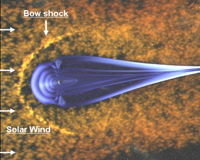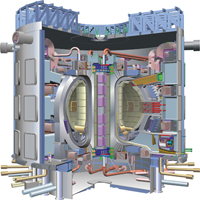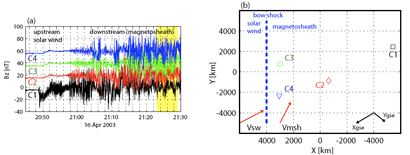Cluster's insight into space turbulence
25 March 2009
The four satellites of ESA's Cluster mission have revealed, for the first time, how turbulence develops in space just outside the Earth's magnetic environment. This result improves the understanding of turbulence, a key physical process by which energy throughout the Universe is transported from large scales at which it is input, to small scales where it is dissipated. |
| Figure 1 Earth's magnetosphere and the bow shock that arises due to the impact of the solar wind. Credit: ESA |
Turbulence is a phenomenon familiar to every air traveler, but how many know that turbulence also exists in space? Just as the turbulence experienced by aircraft is caused by high-speed winds, turbulence in space can be caused by the solar wind, an uninterrupted flow of high-speed solar particles. Thanks to the Earth's magnetic field, most of this solar material is deflected around the Earth's magnetosphere (blue region in Figure 1), delimited by the magnetopause.
The solar wind, when it reaches a magnetized planet, is first decelerated from supersonic to subsonic speed by a shock wave (called the bow shock), located in front of the magnetopause. The region between the bow shock and the magnetopause is called the magnetosheath. This region is one of the most turbulent environments of near-Earth space, making it an excellent laboratory in which to study turbulence. Other environments such as the solar atmosphere, or accretion disks around young stars, are likely to exhibit similar behaviour, but the terrestrial magnetosheath is by far the most accessible place to perform in situ measurements. Characterising the properties of the magnetic turbulence in this region is of prime importance to understand its role in fundamental processes such as energy dissipation or the acceleration of particles to high-energies.
 |
|
| Figure 2 The ITER fusion reactor device. Published with permission of ITER. | Animation 1 Solar flares recorded with the ESA/NASA SOHO satellite. Credit: ESA (For larger versions of this video click here) |
In March 2007, a Nature Physics publication reported for the first time that not only did turbulence exist in the magnetosheath in the form of many small magnetic islands (with a typical size of 100 km), but also that magnetic reconnection occurred within these islands. The observations showed that the turbulent plasma is accelerated and heated during the reconnection process. The discovery of reconnection in turbulent plasma has significant implications for the study of laboratory and astrophysical plasmas, where both turbulence and reconnection naturally develop and thus where turbulent reconnection is very likely to occur. Possible applications range from the dissipation of the magnetic energy in fusion devices on Earth, such as the ITER project (Figure 2), to the acceleration of high-energy particles in solar flares (Animation 1). This discovery was based on data collected by the four Cluster spacecraft when they were flying together in formation with a very short separation distance (~ 100 km).
 |
| Figure 3 Overview of the event: (a) Cluster observations (b) Cluster spacecraft configuration. Credit: ESA |
A more recent study, published on 23 May 2008 in Physical Review Letters, again made use of data collected by the four Cluster satellites but this time with an inter-spacecraft separation of several thousands of kilometers. This configuration enabled the study of magnetosheath turbulence at large scales. Magnetic field data collected on 16 April 2003 by the four satellites (C1, C2, C3 and C4) are plotted in Figure 3a (offset by 20 nT for clarity) while Figure 3b displays the spacecraft positions with respect to the Earth’s bow shock (thick dashed blue vertical line). At this time the Cluster satellites were widely spread in space, from just behind the bow shock (C3 and C4) to more than 8,000 kilometers away (C1), while C2 was located in between. The paper details a complex data analysis of the 4 minute interval marked in yellow in Figure 3a. One property of the turbulence, the intermittency, was studied in particular and was accurately reproduced with a theoretical model. The intermittency appears in the transfer (or the cascade) of the energy from large scales to small scales as an uneven distribution of the energy between the scales and this was used to examine the evolution of the turbulence in the magnetosheath (see Figure 4).
 |
| Figure 4 The measure of the intermittency on all 4 Cluster satellites. Credit: ESA |
"For the first time we use multi-spacecraft observations to characterize the evolution of magnetosheath turbulence. The intermittency significantly changes over the distance, being increasingly stronger away from the bow shock", says Dr. Emiliya Yordanova, lead author of this study.
"Magnetic reconnection, turbulence and shocks are three fundamental ingredients of the plasma Universe. The detailed understanding of these key processes and their associated multi-scale physics is a challenge for the future of space physics. One of the lessons learned from the Cluster mission is the need for new space missions equipped with instruments of higher sensitivity and better time resolution along with a larger number of satellites to sample different scale sizes simultaneously. Such a mission concept exists: a fleet of 12 satellites named Cross-Scale. This is a candidate mission within the ESA Cosmic Vision programme", says Matt Taylor, acting ESA Cluster project scientist.
Reference publication
Yordanova, E., Vaivads, A., André, M., Buchert, S.C., and Vörös Z., Magnetosheath Plasma Turbulence and Its Spatiotemporal Evolution as Observed by the Cluster Spacecraft, Phys. Rev. Lett., 100, 205003, 2008. DOI: 10.1103/PhysRevLett.100.205003
Related publication
Retinò, A., et al., In situ evidence of magnetic reconnection in turbulent plasma, Nature Physics, 3, 235-238, 2007. DOI:10.1038/nphys574
Contact
Emiliya Yordanova, Swedish Institute of Space Physics, Uppsala, Sweden
Email: eya irfu.se
irfu.se
Web story author and co-editor
Arnaud Masson, Science and Robotic Exploration Directorate, ESA, The Netherlands.
Arnaud.Masson esa.int, phone: +31-71-565-5634
esa.int, phone: +31-71-565-5634
Web story editors
Matt Taylor, Science and Robotic Exploration Directorate, ESA, The Netherlands.
Matthew.Taylor esa.int, phone: +31-71-565-8009
esa.int, phone: +31-71-565-8009
Philippe Escoubet, Science and Robotic Exploration Directorate, ESA, The Netherlands.
Philippe.Escoubet esa.int, phone: +31-71-565-4564
esa.int, phone: +31-71-565-4564


